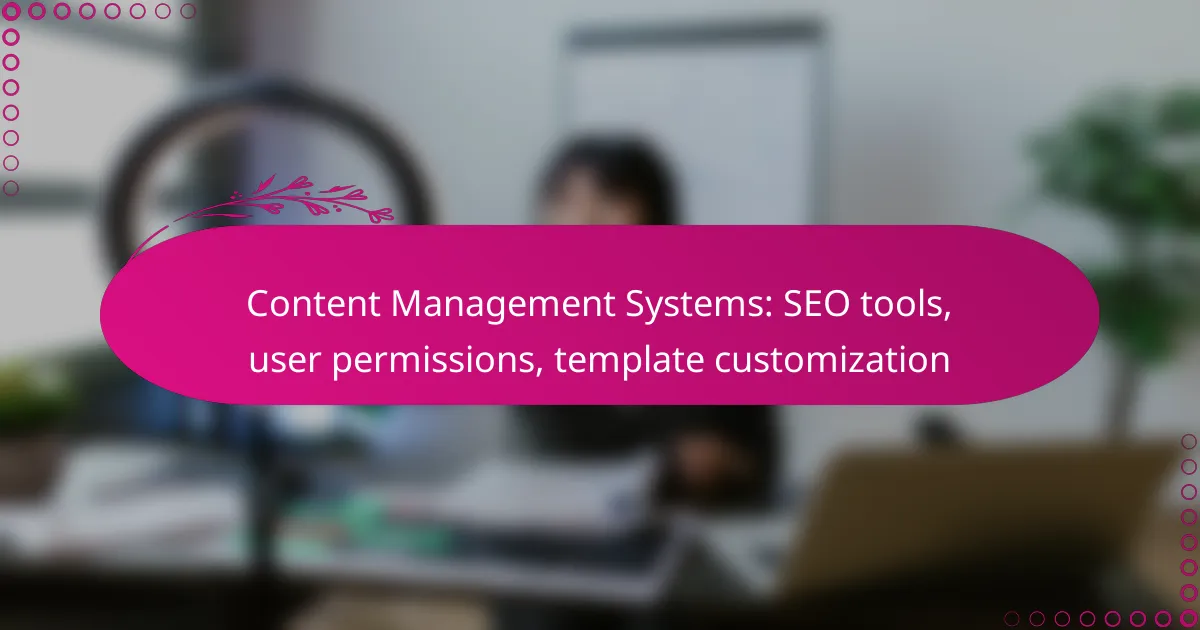Content management systems (CMS) are essential tools for optimizing website performance, particularly in terms of SEO, user permissions, and template customization. By offering robust SEO features and user-friendly interfaces, these platforms empower users to enhance their search visibility while maintaining control over access and security. Additionally, customizable templates enable users to tailor their website’s design and functionality, ensuring a seamless and engaging user experience.

What are the best content management systems for SEO in Australia?
The best content management systems (CMS) for SEO in Australia include platforms that offer robust optimization features, user-friendly interfaces, and flexible customization options. Key considerations include the ability to manage user permissions, utilize SEO tools, and customize templates effectively to enhance search visibility.
WordPress
WordPress is a leading CMS known for its extensive SEO capabilities. It offers a variety of plugins, such as Yoast SEO, which help optimize content, manage meta tags, and generate XML sitemaps. Additionally, WordPress allows for easy customization of templates, making it suitable for different business needs.
When using WordPress, ensure that you regularly update your plugins and themes to maintain security and performance. Also, consider using responsive themes to improve mobile SEO, as a significant portion of web traffic comes from mobile devices.
Wix
Wix is a user-friendly CMS that provides built-in SEO tools, making it accessible for beginners. It features an SEO Wizard that guides users through optimizing their site, including setting up meta tags and alt text for images. Wix also offers customizable templates that are mobile-responsive.
However, while Wix is great for ease of use, it may have limitations in advanced SEO functionalities compared to other platforms. Users should be aware of these constraints when planning their SEO strategies.
Squarespace
Squarespace is known for its visually appealing templates and strong SEO features. It automatically generates clean URLs and provides options for adding meta descriptions and alt text. Squarespace also includes analytics tools to track site performance and user engagement.
For optimal results, leverage Squarespace’s built-in SEO features while ensuring that your content is high-quality and relevant. Regularly updating your site with fresh content can also help improve search rankings.
Shopify
Shopify is a popular CMS for e-commerce businesses, offering various SEO tools tailored for online stores. It allows users to edit title tags, meta descriptions, and URL structures, which are crucial for product visibility in search engines. Shopify also supports responsive design, enhancing mobile user experience.
When using Shopify, focus on optimizing product descriptions and images to improve SEO. Additionally, consider implementing structured data to help search engines understand your products better, which can lead to enhanced visibility in search results.
Joomla
Joomla is a flexible CMS that provides advanced SEO features suitable for more experienced users. It allows for extensive customization of URLs, meta data, and site structure, which can significantly impact search engine rankings. Joomla also supports various extensions for enhanced SEO functionality.
To maximize Joomla’s SEO potential, ensure that you are familiar with its settings and configurations. Regularly audit your site for broken links and optimize content to keep it relevant and engaging for users.

How do user permissions work in content management systems?
User permissions in content management systems (CMS) dictate what actions users can perform within the platform. These permissions help maintain security and organization by controlling access to various features and content based on user roles.
Role-based access control
Role-based access control (RBAC) is a method of restricting system access to authorized users based on their assigned roles. In a CMS, roles such as administrator, editor, and contributor define what users can see and do. For example, administrators may have full access to all features, while contributors can only create and edit their own content.
Implementing RBAC simplifies permission management by grouping users with similar responsibilities under a single role. This approach reduces the complexity of managing individual permissions and enhances security by ensuring that only the right users have access to sensitive areas of the CMS.
Custom user roles
Custom user roles allow organizations to tailor permissions to fit specific needs beyond the default roles provided by the CMS. This flexibility enables businesses to create roles that align with their unique workflows and team structures. For instance, a marketing team may require a role that combines editing capabilities with access to analytics tools.
When creating custom roles, it’s crucial to balance functionality with security. Avoid granting excessive permissions that could lead to accidental changes or data breaches. Regularly review and adjust these roles as team dynamics and project requirements evolve.
Permission levels
Permission levels define the extent of access and actions a user can perform within a CMS. Common permission levels include view, edit, delete, and publish. Each level can be assigned to different roles, allowing for granular control over what users can do with content.
For effective management, consider implementing a tiered permission system where higher-level roles inherit permissions from lower ones. This structure can streamline the process of assigning permissions and ensure that users have the necessary access to perform their tasks without compromising security.

What are the key features of template customization in CMS?
Template customization in Content Management Systems (CMS) allows users to modify the appearance and functionality of their websites to meet specific needs. Key features include drag-and-drop editors, responsive design options, and pre-built templates, which collectively enhance user experience and streamline website management.
Drag-and-drop editors
Drag-and-drop editors simplify the process of creating and customizing web pages by allowing users to easily place elements where they want them. This feature eliminates the need for coding knowledge, making it accessible for beginners and non-technical users. Look for editors that offer a variety of elements, such as text boxes, images, and buttons, to enhance your design flexibility.
When using drag-and-drop editors, be mindful of layout consistency and loading times. Overloading a page with too many elements can lead to slower performance, which may negatively impact user experience and SEO rankings.
Responsive design options
Responsive design options ensure that your website looks good on various devices, from desktops to smartphones. This feature automatically adjusts the layout and content based on the screen size, providing a seamless experience for users. Prioritize templates that are mobile-friendly, as a significant portion of web traffic comes from mobile devices.
To test responsiveness, use tools like Google’s Mobile-Friendly Test. Regularly check your website on different devices to ensure that all elements display correctly and maintain functionality.
Pre-built templates
Pre-built templates offer a quick starting point for website design, allowing users to select a layout that fits their needs without starting from scratch. These templates often come with customizable features, enabling users to adjust colors, fonts, and images to align with their branding. Choose templates that are well-rated and frequently updated to ensure compatibility with the latest web standards.
While pre-built templates save time, be cautious of over-customization, which can lead to a cluttered design. Stick to a cohesive style and ensure that your website remains user-friendly and visually appealing.

What are the SEO tools available in popular CMS platforms?
Popular content management systems (CMS) offer a variety of SEO tools designed to enhance website visibility and performance in search engines. These tools help users optimize their content, manage metadata, and analyze site performance effectively.
Yoast SEO for WordPress
Yoast SEO is a widely used plugin for WordPress that provides comprehensive tools to optimize content for search engines. It offers features such as keyword optimization, readability analysis, and automated XML sitemaps, making it easier for users to improve their site’s SEO.
To get started, install the Yoast SEO plugin and follow the setup wizard. Focus on the content analysis feature, which provides real-time feedback on keyword usage and readability scores. Regularly check the SEO analysis to ensure your posts are optimized before publishing.
SEO Wizard in Wix
The SEO Wizard in Wix guides users through the process of optimizing their websites for search engines. This tool provides step-by-step instructions tailored to the specific needs of the site, including suggestions for improving page titles, descriptions, and alt text for images.
To utilize the SEO Wizard, access it from the Wix dashboard and follow the prompts. It’s crucial to regularly update your SEO settings as you add new content. Pay attention to the recommendations provided, as they can significantly impact your site’s visibility.
Built-in SEO features in Squarespace
Squarespace includes built-in SEO features that help users optimize their websites without needing additional plugins. Key functionalities include customizable page titles, automatic XML sitemaps, and clean URLs, which enhance the site’s search engine friendliness.
To make the most of Squarespace’s SEO capabilities, ensure that each page has a unique title and description. Regularly review your site’s analytics to identify areas for improvement. Remember to utilize the built-in tools for social sharing, as they can enhance your site’s reach and engagement.

What criteria should you consider when choosing a CMS for SEO?
When selecting a content management system (CMS) for SEO, prioritize features that enhance search engine visibility and user engagement. Key criteria include the availability of SEO plugins, customization options, and the overall user interface.
SEO plugin availability
SEO plugins are essential tools that help optimize your website for search engines. Look for a CMS that supports popular SEO plugins like Yoast SEO or All in One SEO Pack, which can assist with on-page optimization, sitemaps, and metadata management.
Check if the CMS allows easy installation and configuration of these plugins. A system with a robust plugin ecosystem can provide additional functionalities, such as social media integration and performance tracking.
Customization flexibility
Customization flexibility is crucial for tailoring your website to meet SEO best practices. Choose a CMS that allows you to modify templates and layouts without extensive coding knowledge, enabling you to create a user-friendly experience.
Consider whether the CMS supports custom themes and plugins that align with your branding and SEO strategy. A flexible system can help you implement responsive design, fast loading times, and structured data, all of which are important for SEO.
User-friendly interface
A user-friendly interface simplifies the content creation and management process, making it easier to focus on SEO. Look for a CMS with an intuitive dashboard that allows quick access to essential tools and features.
Evaluate the learning curve associated with the CMS. A platform that offers clear documentation and support resources can help you and your team efficiently manage content and implement SEO strategies without unnecessary delays.

How can you optimize user permissions for better SEO?
Optimizing user permissions can significantly enhance your site’s SEO by ensuring that only authorized users can make changes that affect search engine visibility. Properly configured permissions help maintain content integrity and prevent unauthorized edits that could harm your site’s ranking.
Understanding User Roles
User roles define what actions individuals can perform within a content management system (CMS). Common roles include administrators, editors, authors, and subscribers, each with varying levels of access. For SEO, it’s crucial to limit high-level permissions to trusted users to avoid accidental changes that could negatively impact site performance.
Setting Permissions Strategically
When setting permissions, consider the principle of least privilege, granting users only the access necessary for their tasks. For example, editors may need to publish content but should not have access to site-wide settings. Regularly review and adjust permissions to ensure they align with current team roles and responsibilities.
Monitoring Changes and Access
Implement tools to monitor changes made by users with editing permissions. This can include version control systems or activity logs that track who made changes and when. By keeping an eye on these modifications, you can quickly identify and rectify any alterations that might adversely affect your SEO efforts.
Training and Best Practices
Educate your team on best practices for content creation and editing to minimize SEO risks. Provide guidelines on keyword usage, meta tags, and internal linking strategies. Regular training sessions can help ensure that all users understand the importance of maintaining SEO-friendly practices while managing content.
